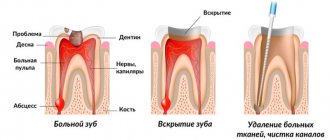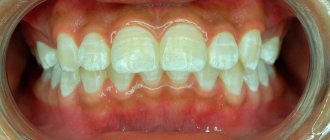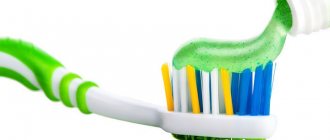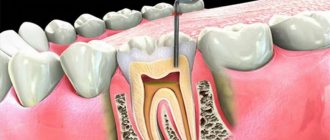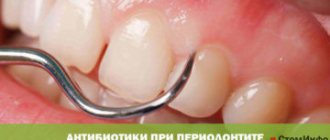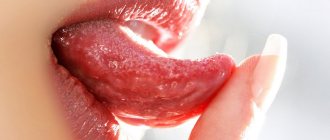Causes of blackening of teeth near the gums
The condition of tooth enamel is affected by various household factors, as well as systemic and dental diseases.
Household causes of darkening of the gum area include:
- frequent consumption of coffee, tea or red wine;
- smoking abuse;
- presence of natural juices (grape, tomato) in the diet;
- Let's take medications containing iron gluconate.
Coloring drinks and juices contribute to the appearance of dark pigmentation on the enamel, which is temporary and is removed after hygiene procedures.
Pathological processes that cause the formation of black plaque on the teeth near the gums:
- carious lesions;
- fluorosis is a disease associated with excess fluoride in the body;
- cervical caries;
- presence of tartar.
Cervical caries is one of the causes of dark spots
If the tooth turns black near the gum, this may be a symptom of the progression of cervical caries - a carious process localized in the cervical region.
Cervical caries is considered one of the most dangerous types of tooth damage, as it occurs in a latent form, affects tooth enamel in a vulnerable place and destroys it at an accelerated pace.
Pathology has a gradual development:
- The appearance of a pigmented spot in the neck of the tooth near the gum.
- Formation of a rough surface of the affected area.
- Increased sensitivity to external irritants - hot, sour, cold foods, pain.
- Change in color of the spot from light brown to black.
Deep cervical caries is characterized by significant destruction and is complicated by the development of pulpitis.
►►► Here! Read a detailed article about cervical caries and methods of treating this disease.
Why do children's teeth turn black?
Children's milk teeth are susceptible to carious lesions much more intensely than molars, since they do not have a dense structure. The enamel darkens due to the development of pathological processes in the oral cavity, which in children are provoked by:
- congenital fragility of enamel;
- calcium deficiency;
- irregular oral hygiene;
- vitamin deficiency;
- chipped teeth;
- endemic fluorosis;
- chronic diseases of the gastrointestinal tract;
- hereditary factor.
Nighttime bottle feeding is often considered the cause of blackening of teeth in children under 2 years of age. When drinking milk or formula at night, saliva production decreases. The acids formed on the teeth during feeding are not washed away naturally and start the process of destruction of the enamel.
The tooth darkened after treatment, why?
Some patients notice that after treatment, teeth lose color and become darker than neighboring teeth. With what it can be connected?
First of all, modern treatment methods do not imply any change in tooth color after treatment. This has sometimes happened before for many reasons.
If the tooth is alive, the filling on it may darken. Then the problem is either the filling material or the patient’s failure to comply with the doctor’s recommendations. For example, the patient immediately after treatment ate or drank something containing strong dyes. This happens extremely rarely, but it does happen.
Much more often, teeth darkened during root canal treatment. If the canal was not completely cleaned and there was an infection, blood residue or something else in it, then after treatment the tooth could be painted in different colors.
If materials containing resorcinol-formalin were used when filling the canal, the teeth could be stained reddish. Since for a long time teeth were filled with such pastes only in the USSR, a special name for such teeth even appeared in international practice - “red Russian teeth”.
At one time, people managed to fill teeth with pastes containing silver or with silver pins. And very soon they realized that they couldn’t do that. Silver oxidizes over time, producing black oxides, and this inevitably leads to the tooth turning black.
But the most disgusting thing is that not only the tooth can turn black, but also the gums in the area of the root of this tooth. There is also a special name for this - “silver gum tattoo.” This gum remained black forever. Even tooth extraction does not help restore the color of the tattooed gum, and the only treatment option is surgical tissue transplantation.
Therefore, modern dentistry categorically does not recommend filling tooth canals with anything other than gutta-percha. It does not stain tooth tissue, lasts a long time and, if necessary, allows you to refill the canal without any problems.
If the canals are filled with different cements, they sometimes become so hardened inside the tooth that it is not possible to open the canal and go through it again.
The metal from the crowns can also stain the tooth. Sometimes the alloys of the metal frame of the crowns also contain substances that stain the tooth and gum tissues, and then bluish-grayish rims appear around the crowns over time, which are then very difficult to remove and disguise with new crowns.
Therefore, today it is considered the best to use crowns based on zirconium dioxide. It does not oxidize, is white in color and does not change color throughout its service life.
Professional dental care
Treatment of blackening of teeth near the gums in the dental office includes several stages:
- Elimination of the reasons that provoked the color change.
- Bleaching.
If the surface of the tooth near the gum has turned black due to the presence of cervical caries, measures must be taken to eliminate it. Treatment options for blackening will depend on the stage of enamel damage:
- At the black spot stage, remineralizing therapy is used: the tooth surface is cleaned of plaque and stone, and applications with fluoride-containing compounds are applied to the affected area.
- At the stage of superficial caries, the affected area is polished and eliminated.
- In case of average caries, the damaged part of the tooth is removed, the area is treated with a special preparation and a filling is installed.
- In case of deep caries, the pulp is removed and the canals are cleaned, after which a filling is installed.
If the tooth turns black at the gum due to tartar deposits, the affected areas are cleaned using one of the selected methods:
- mechanical – manual method using special tools;
- chemical - removal of solid deposits using compounds based on alkalis and acids;
- ultrasonic cleaning – devices that emit sound waves are used to clean enamel;
- laser – removal of tartar with a laser.
The teeth whitening procedure is the final stage of cleansing the enamel from darkened plaque. For this purpose use:
- laser installations;
- ultrasound;
- chemical compositions;
- special lamps.
A tooth turns black - what to do?
People often ignore the presence of dental problems, but any person will be interested in the fact that his tooth has suddenly turned black. External or internal dark plaque on a tooth not only affects the smile, it can lead to inferiority complexes, and sometimes is a sign of serious illnesses. What causes teeth to turn black and what to do if a tooth turns black? It is necessary to establish the cause of the problem and begin to treat it.
The main causes of blackening of teeth include:
Features of treatment of the disease
An experienced dentist can treat root caries at the first stage without drilling. In this case, the doctor performs professional cleaning, removes plaque and stones. Then the enamel is remineralized (restored) with a special agent - a gel based on calcium and fluoride. After several remineralization sessions, complete regeneration of the outer shell of the tooth occurs.
At more severe stages of the disease, treatment is carried out using the same methods as for other types of dental caries. However, the procedure can be complicated by the fact that caries is located near the gums.
The process of surgical dental intervention includes several stages.
- Anesthesia. The defect is located too close to the gum and during drilling any movement of the dentist can cause severe pain to the patient, so before the procedure the gum is frozen using a special means.
- Cleaning the tooth from plaque and tartar. During the procedure, the dentist determines the color of the future filling.
- At the next stage, the doctor carefully pushes back the gum if it is affected by caries.
- Then the dentist begins to fill out the carious cavity and removes all dead tissue.
- Next, the cavity is treated with an adhesive - a special substance that promotes adhesion of different materials (tooth surface and filling).
- In the next step, the dentist fills the cavity with a filling. It is applied in layers and each layer is exposed to a photopolymerization lamp. The doctor then grinds and polishes the filling, giving the tooth its natural anatomical shape.
In the future, teeth need constant care. A carious process in the cervical area can occur even next to an installed filling. In addition, if care is improper, there is a risk of secondary caries.
In the future, teeth need constant care. A carious process in the cervical area can occur even next to an installed filling. In addition, if care is improper, there is a risk of secondary caries.
Why can a child's teeth turn black?
The list of reasons why children's teeth darken is somewhat different from why adults' teeth darken. The most common reasons for darkening of children's enamel include:
- Fluorosis. The disease is associated with an excess of fluoride in drinking water and is the most common reason why teeth turn black in children and some adults. Fluorosis can be identified by characteristic damage to the enamel - it becomes covered with light and dark spots.
- Poor nutrition. Plaque on the teeth of children is formed not only due to insufficient oral hygiene, but also due to an incorrectly formulated diet, including a large amount of industrially produced sweets and carbonated drinks with a high sugar content.
- Early caries. A feature of the development of caries on primary incisors, canines and molars is its rapidity: before the tooth begins to hurt, a carious lesion can destroy most of it.
- Taking antibiotics by the mother during pregnancy.
- Metabolic disease.
- Dysbacteriosis.
- Genetic predisposition.
After the procedure, you need to keep your mouth clean by regularly cleaning the enamel twice with a brush and paste, which the doctor will select individually. The dentist will demonstrate to the patient the correct cleaning technique, in which plaque will be efficiently removed not only from the front incisors, but also from the distant molars. After each meal, you need to use rinses that restore the acid-base balance in the mouth.
Possible causes of blackening of gums in children and adults
If an adult’s gums are black, this may be due to one of the following reasons: (see also: after tooth extraction, gums become black)
- Stomatitis is an inflammation of the oral mucosa. The spots on the gums that appear as the disease develops are white with a yellowish tint. However, with deep inflammation or bleeding, they darken.
- Blackening of the gums often occurs in heavy smokers. This phenomenon is caused by contact of cigarette smoke with the oral mucosa. In response to irritation, epithelial cells produce melanin, a pigment synthesized during tanning.
- Tartar deposits growing on and under the gum line cause darkening of the mucous membrane.
- Untreated caries that has reached the pulp and periodontium can also cause discoloration of the soft tissue. It can occur hidden, destroying the tooth from the inside - it is almost impossible to discern the pathology from the outside. In the advanced stage, the disease is reflected in the appearance of the mucous membrane: it turns black at the base of the tooth, and slight swelling appears (we recommend reading: why does the tooth turn black on different sides?).
- Blackening of the gums around the tooth can occur for natural reasons - with age. However, in young people, brown or purple spots indicate a problem.
- A black dot can form due to strong mechanical impact: impact or injury (we recommend reading: black dots on teeth: what are they and how to get rid of them?). This leads to capillary rupture and blood flow into the soft tissue. You can see a purple bruise or bump on the gum, which over time changes color to brown and yellow (we recommend reading: why does a bump appear on the gum and how to treat it?).
- Thermal or chemical burns lead to the death of soft tissues and the formation of black-gray spots.
- Dark spots appear when wearing dentures or when the mucous membrane is injured by the sharp edge of a tooth. Such problems arise due to improperly performed fillings or miscalculations in the manufacture of artificial teeth.
- Amalgam, which was previously often used as a filling material, causes discoloration of the gum tissue near the tooth. The alloy of silver and mercury stains the mucous membrane, and hot food accelerates this process.
- lack of calcium;
- caries;
- dysbacteriosis;
- enamel hypoplasia;
- weak immunity;
- eating foods containing dark pigment.
Drug treatment for darkening of teeth near the gums
What to do if the teeth near the gums turn black? Use local and systemic drugs to eliminate the problem, the choice of which depends on the reasons that provoked the development of the pathology.
Local treatment involves the use of remineralizing therapy, which includes the following drugs:
- Remodent is an anti-caries agent that replenishes calcium and fluoride deficiency. It is used in the form of solutions and applications (1 portion of the substance per 100 ml of water). A cotton swab is moistened in the resulting solution and applied to the affected area for 15–20 minutes. The procedure is carried out 2 times a week.
- A combination of calcium gluconate and sodium fluoride solutions.
To whiten teeth blackened due to smoking abuse, use:
- preparations in the form of gels containing carbamide peroxide;
- concentrated solution of hydrogen peroxide.
The duration of the course is 10–14 days.
Popular products for removing black plaque:
- Superoxol;
- Denta Lite Plus;
- Perfection White;
- Prema;
- Opalescence.
To eliminate dark spots in the gum area of non-carious origin (enamel erosion, fluorosis), the following are used:
- preparations with calcium gluconate in the form of applications every other day, 1 time per day;
- taking vitamins (retinol, thiamine, calcium lactate, phytin).
If blackening of the teeth near the gums provokes deep caries, the following is prescribed:
- Calcemin;
- Radoplast;
- Calcidonite.
Folk remedies
If the tooth surface near the gums is black, you can use traditional medicine that has a whitening effect without the risk of damaging the enamel.
Effective recipes for use at home in the presence of dark plaque:
- 1 tsp. Mix baking soda and hydrogen peroxide in a separate container. Apply the prepared mixture to the neck of the tooth near the gum using a cotton pad. After the procedure, rinse your mouth with warm water.
Prolonged and frequent exposure to hydrogen peroxide can damage tooth enamel, so the procedure should be repeated no more than once a week.
- Mix 2 tsp. dried sage leaves and 2 tsp. sea salt. Place the resulting mixture on foil and dry in the oven at 180C for 20 minutes. Use ready-made teeth cleaning product.
- Grind 3 tablets of activated carbon into powder. Dip a damp toothbrush into the crushed preparation and brush your teeth for 2-3 minutes, paying special attention to the affected areas near the gums. Repeat the procedure 1-2 times a week.
Prevention of plaque
To prevent blackening of the enamel in the gum area, you need to follow simple rules for oral care:
- carry out hygiene procedures regularly;
- visit the dentist for timely sanitation of the oral cavity;
- lead a healthy lifestyle;
- eat a balanced diet;
- At the first signs of damage to tooth enamel, consult a doctor.
Blackness in the area of the neck of the tooth near the gum not only spoils the aesthetic appearance of the smile, but can also lead to the destruction of the enamel. To eliminate darkened stains, a set of measures has been developed, consisting of dental procedures and the use of medications, which is aimed at strengthening and whitening tooth enamel.
Bibliography
- Murovyannikova Zh.G. – Dental diseases and their prevention, Rostov n/a: Phoenix, 2011.
- Dmitrieva L.A. — Modern aspects of clinical periodontology, M., 2001.
- Yakovleva V.I. – Diagnosis, treatment and prevention of dental diseases, Minsk 1994.
- Borovsky E.V. and co-authors - Therapeutic dentistry, M. 1998.
- Borovsky E.V., Leus P.A. — Dental caries, M., Medicine, 1979.
- Pakhomov G.N. - Primary prevention in dentistry, M., Medicine, 1982.
- Ulitovsky S.B. — Encyclopedia of Preventive Dentistry, St. Petersburg, 2004.
- Kuryakina N.V. - Therapeutic dentistry of children, - Medicine, 2004.
Find a clinic
After implantation, the gums turned blue: other symptoms and diagnosis of peri-implantitis
Regardless of the reasons that caused peri-implantitis, this disease can be characterized not only by changes in the color of the gums, but also by other symptoms. These include bleeding gums in the area of the dental implant, deformation of the gums in this area, mobility of the crown, as well as painful or uncomfortable sensations in this localization.
Only a dentist can diagnose peri-implantitis when conducting an objective examination of the patient’s oral cavity. As a rule, this complication is characterized by all signs of inflammation and may involve swelling and redness, a local increase in temperature in the soft tissues of the oral cavity, etc.
When contacting the Apex dental clinic, already at the initial appointment, the doctor will accurately determine the cause of darkening of the gums after installation of the implant,, if necessary, prescribe additional instrumental research methods (radiography), and also select an individual treatment regimen.
By choosing the Apex dental clinic, you are making a choice in favor of high-quality dentistry and a quick solution to all dental problems that arise!

